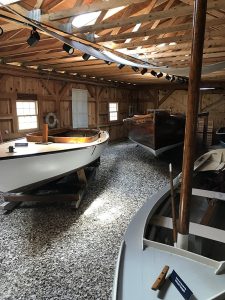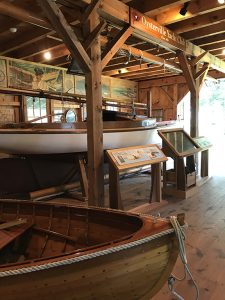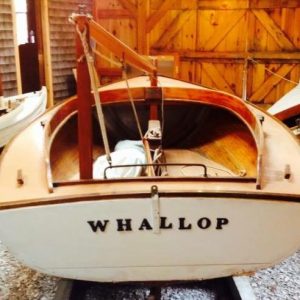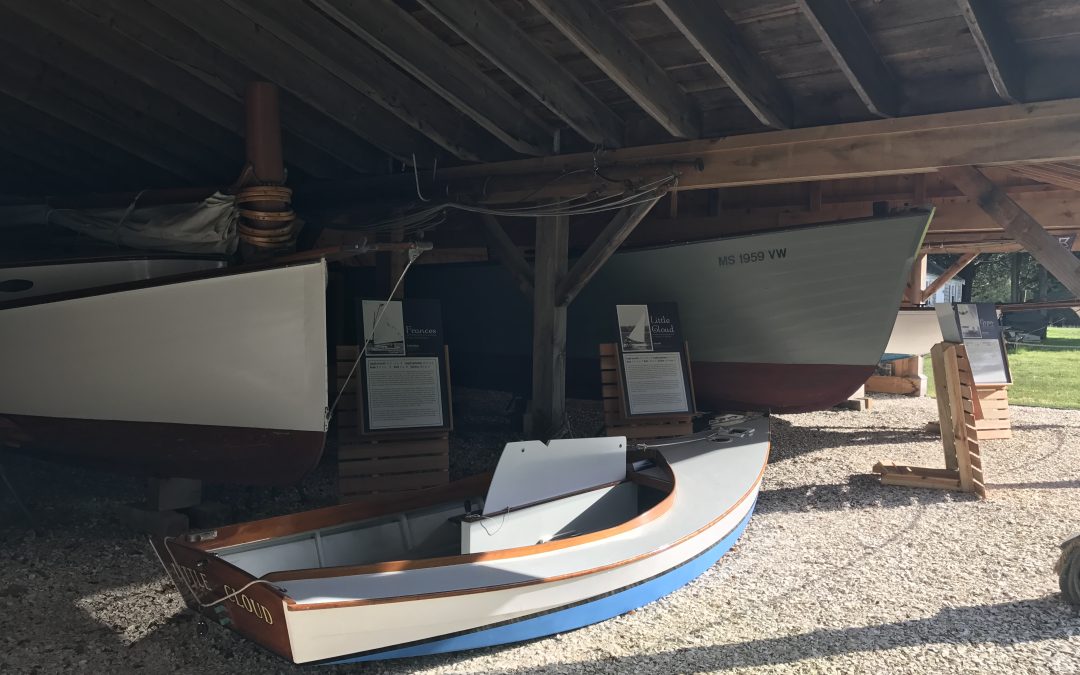By BARBARA CLARK

Courtesy OSTERVILLE HISTORICAL MUSEUM
On a perfect Cape Cod summer day, the sun dapples through the trees at the two-acre grounds of the Osterville Historical Museum. A visit there is a treat for visitors and locals alike, with its simple, relaxed setting, picnic tables and inviting spaces set under welcoming shade trees, and vintage buildings and boats that invite a look back at Osterville’s past. According to the museum, “The story of Osterville starts here.”
A standout feature of the museum complex is its stunning wooden boat collection, housed in an interconnected series of vintage boat sheds that contain more than a dozen classic wooden boats, viewed alongside working tools of the boatbuilding trade, artworks and colorful histories and photos of the boats. The watercraft on view here comprise the largest collection of wooden boats in Massachusetts.
The sturdy, picturesque boat sheds include buildings such as the original 1850s Herbert F. Crosby boat shop and the 1930s-era Wianno Senior shed. The more-recent Van Winkle boat shed, added in 2015, showcases the New Jersey skiff Eagle, with its 40 years of history sailing in local waters; and the classic one design Gypsy, which first sailed in 1914 under the name Witch. In 2008 Gypsy was named to the National Register that lists boats of historic significance. It remains a classic example of the golden age of yachting in its heyday of the early 20th century.

Courtesy OSTERVILLE HISTORICAL MUSEUM
Crosby Boats Make Osterville History
The Crosby name is central to nearly 200 years of historic wooden boatbuilding history, as well as to Osterville’s maritime legacy. The very first Crosby boats were constructed in 1798, and the company gained public notice with its official establishment in 1850. The Crosbys are considered to be America’s oldest currently active wooden boatbuilding family. In the current day, Ned Crosby, in the eighth generation of Crosbys, continues to build and restore wooden boats.
Their historic name is bookmarked by the creation of two main Crosby designs, the Crosby catboat and the Wianno Senior. Both classic designs have pride of place in the museum’s boat shed displays.
‘Quick As A Cat’
The history of catboats is a long one. The original Crosby catboat Little Eva took to the water in 1850, and the popular boat is still being built in a variety of sizes, famous for its distinctive and elegant proportions, wide beam, mast set well forward and large “barn door” rudder. Early on, “Quick as a cat” gave the boat design a name that has stuck.
The seaworthy boats are at home on the water, both in the world of sailboat racing and as craft that became predominantly useful for commercial fishermen, credit due to the craft’s hold capacity, offering ample room to store the day’s catch.
The Crosby legacy is prolific: Since Little Eva first sailed, more than 3,500 boats have been built by the Crosby family.

Courtesy OSTERVILLE HISTORICAL MUSEUM
Wianno Senior Design Created A Level Playing Field For Racing
The year 1914 marked the inauguration of the Crosbys’ Wianno Senior, a gaff-rigged centerboard one-design sloop. From the outset this boat design was built to conform to an exact, uniform mold, which, according to Jennifer Williams, the museum’s executive director, resulted in a “level playing field” for competitive racing.
Starting in the early part of the 20th century, the Wianno Senior and Crosby catboats became sailing and racing staples in the waters of Nantucket Sound, where Osterville sailors enjoyed weekend racing competitions and regattas. Racing became a widely popular summer pastime in well-heeled yachting circles, as onlookers along the promenade on Osterville’s Seaview Avenue enjoyed the salt air, sun and sea breezes, making a colorful sight with their summertime suits, long skirts and jaunty parasols.
The boat’s reputation later gained worldwide renown as photos circulated of the John F. Kennedy family’s 25-foot Wianno Senior, Victura, plying the waters of Nantucket Sound during the famous family’s sailing heyday at mid-century.
No Computer Designed These Boats
According to Williams, beginning in the early days, sailboats were designed and “built by eye.” Shipwrights first carved what are known as half hull models—a scale model preview in relief of what the finished craft would look like, ensuring its unique design and symmetry. The boat builder could then use the carved model to render the vessel’s design on paper. “No computer designed these boats,” she said.
One of the Osterville sheds contains a selection of these unique half hull models, many carved by Osterville shipwrights. Today they’re considered works of art, conveying the history and flavor of an exciting era of sail.
Murals And An Herb Garden
Scattered around the museum complex are historical buildings that link to Osterville’s legacy in the community and on Cape Cod. They’re open to the public for walk-throughs as well as weekly tours.
The rambling 1820s-era Captain Jonathan Parker House was originally built as a half-Cape-style house, and the building has been expanded many times over the years. The twisty, turn-y interior contains historical area maps, furniture and art, including works painted by famed Depression-era Works Progress Administration artist Vernon Coleman. Among the longtime Cape resident’s works are murals that were uncovered in 2016 from behind a wall that was being excavated when the old Mayflower Restaurant in Hyannis was sold and renovated. The late artist’s works recall his varied career, which includes more than 100 murals for the WPA art program, and 25 years teaching art in Barnstable public schools, including Osterville Bay School.
Also on site is the 1720 Cammett House, the oldest house in Osterville, fronted by a Colonial-era herb garden whose collection of plants recalls an era when kitchen gardens grew plants and herbs for both cooking and health purposes, such as peppermint, geranium, sage, lamb’s ear, bee balm and other useful and aromatic plants. Brochures inside the house list all the herbs grown here, with the on-site gardens all overseen by the Osterville Garden Club.
An additional small building is the Jelly House, a child-sized cottage that once was one of many that sat along Route 6A prior to World War II, selling tasty Cape Cod jams and jellies from the Green Briar Kitchen. After the war these cottages were sold off to become children’s playhouses.
‘Oh Me, Oh My, Love That Country Pie!
There are nautical flags flying, fairy lights in tree branches, and baskets and boxes of delicious market produce from Osterville farms as well as from the Dartmouth and Rochester farming areas. On the June opening day of its 16th year, the Osterville Farmers Market at the museum welcomed sunshine, festivity and a group aura of “at last—finally it’s summer,” with the crowd ranging from oldsters to babies in strollers. Everyone savored the breeze and outdoor ambiance, and especially the variety of colors—bright red strawberries, salad greens, pink-hued rhubarb and bright yellow-orange nasturtium plants, all alongside tasty edibles to try out right there, from fresh cider donuts to made-on-the-spot kettle corn. The colors of the garden goodies matched with the hues of climbing roses, peonies and phlox, with tiny pink and purple hydrangea blossoms getting set to pop.
According to Williams, this is the original and only farmers market in Barnstable Village.
The Osterville Historical Museum blooms each year with its exhibits and weekly farmers market, as well as the summer festival called Art at the Museum and December’s light-filled Festival of Trees.
One local artist, Williams said, has called the museum “the front porch of the village.”
If you visit:
Osterville Historical Museum
155 West Bay Road
508-428-5861
Open 10 AM to 2 PM, Thursday through Saturday, through Oct. 10
Farmers market: 9 AM to 1 PM, Fridays through Oct. 10

